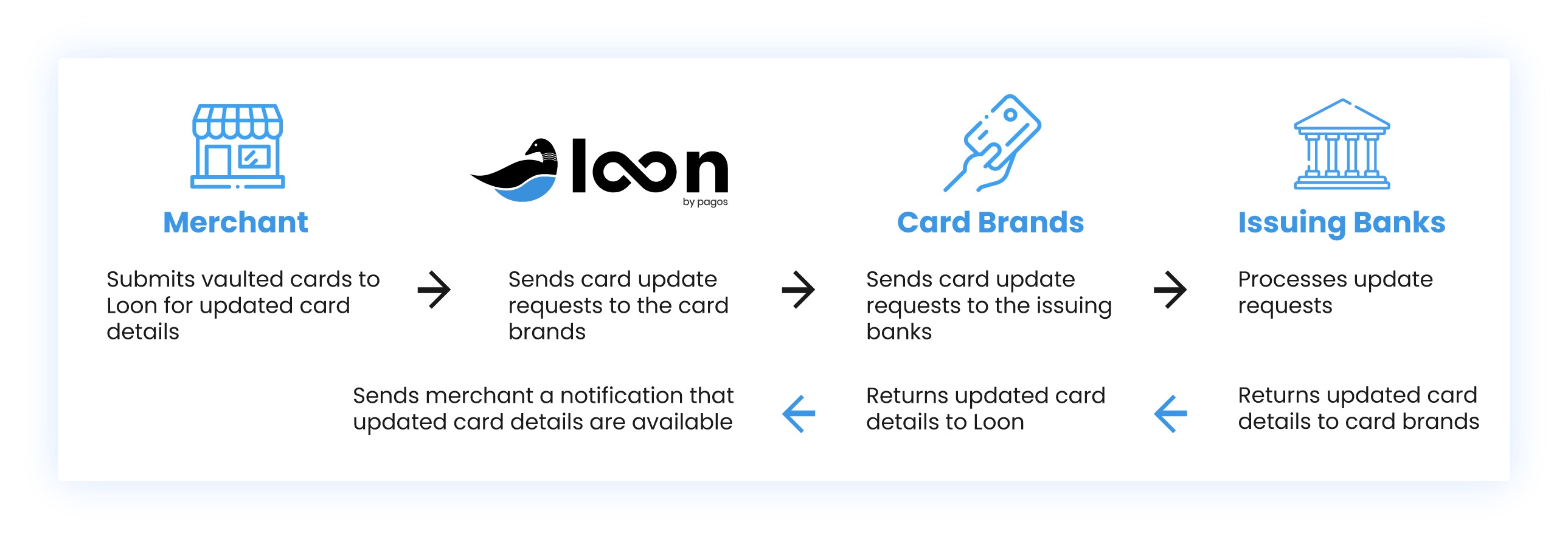Skip to main contentAccount updater is a program offered by the major card brands (e.g. Visa, Mastercard, Amex, and Discover) to help businesses keep vaulted card data fresh. It relies on the secure exchange of updated account information from card issuers, through card brands, and on to merchants like you who store customer card data in secure vaults. This service ensures that when customer card details change—due to lost, stolen, or expired cards—their payment information automatically stays up-to-date in your vault.
Account Updater Flow
Each card brand has their own version of account updater, and each version requires its own unique integration. Once integrated, you’ll receive updated card information via the following flow for each individual card brand:
-
You submit a request to the card brand for updated card details.
-
The card brand sends an update request to the issuing bank.
-
The issuing bank processes the update request and returns updated card details to the card brand.
-
The card brand returns the card details to you.
Account Updater Flow With Pagos
Pagos’ Account Updater is an easy-to-use, global solution that is independent of card brands or payment service providers. With Pagos, you only need to manage one relationship, one integration, and you’ll get access to account updater services and data for all four major card brands (Visa, Mastercard, Amex, and Discover)—regardless of your processor or processors.
The flow with Pagos looks like this:

Benefits of Account Updater
Inevitably, vaulted card details will change and go stale. Account updater programs ensure you stay on top of changes, thus improving approval rates, reducing churn, and providing better customer experiences with your brand.
Increasing Approval Rates
Using an account updater solution can decrease how often issuing banks decline your authorization attempts because of outdated cardholder payment information. Examples of these types of declines include:
-
Card has expired or the expiration date has changed
-
Card has been updated due to being lost or stolen
-
Card has been reissued due to a new card program, a new card brand, or fraud
-
Customer details such as customer name or address have changed
The cost of these types of declines compounds on your business. On top of the lost revenue from the failed transaction, you’ll pay a fee for your authorization attempt. Beyond the direct financial impact, this failed transaction drops your authorization rate and increases your decline rate—two KPIs you’re likely monitoring for your business. Finally, if the cardholder whose transaction failed doesn’t take the time to update their card information and try again, you may have not just lost the revenue from this single purchase, but from a lifetime of future purchases—otherwise known as the customer’s lifetime value.
By using an account updater solution, you can stay ahead of declines by receiving fresh card details ahead of time, resulting in more sales for you and a lift in your overall authorization rates.
Reducing Churn
Roughly 30% of payments cards in the United States alone are re-issued annually. Imagine not being able to authorize and charge 30% of the cards stored in your vault every year. That’s a lot of missed revenue and potential customer churn. With account updater, you can reduce declines related to re-issuance (e.g. AVS mismatches, expired cards, and lost or stolen events), and ultimately recover anywhere between 2-10% of your monthly revenue.
Account Updater Churn Example
How much could a 10% decrease in declines could improve your bottom line? Consider a situation where your business has an average order value of $25 and you sell 1,000 recurring subscriptions a month. Typically, 100 of those transactions fail due to declines (a decline rate of 10%). As a result, you make $22,500 a week.
$25 x (1,000 attempted transactions – 100 declines) = $22,500
Now imagine you enrolled in account updater and improved your decline rate by 10%, meaning only 90 of your attempted transactions fail a month. Now you’re making $22,750 each month:
$25 x (1,000 attempted transactions – 90 declines) = $22,750
That’s a $250/month value that required zero work on your part outside of the original account updater integration.
Staying with this example, we can explore the long-term impact on future revenue of not using account updater and continuing to lose those 10 extra subscribers each month. When you lose a customer this month, you cut short their lifetime value to your business. If you expect a customer to stay with your business for 1 year (12 billing cycles), and they drop off on the 2nd billing cycle, the value of a single decline can also be thought of as 11 missed months at $25 each, or $275. The inverse is also true; by saving a single transaction, you stay on track to bring in the expected lifetime value of your customer, and you avoid the risk that they churn due to the frustrations of unintentional payment failures.
Improving Customer Experiences
Whenever a customer gets a new credit or debit card, they face the overwhelming prospect of updating their card details on file with every business they frequent or subscribe to. In the event that they forget to update one and try to make a purchase with old payment card information, they’ll face a transaction decline.
As a business, using account updater and keeping your vaulted cards up-to-date helps avoid any service disruptions for your customers. More specifically, it eliminates the need for them to log in or contact customer service to manually update their card details. This provides them with a better overall experience of your service or product and prevents a potential loss of sales! 